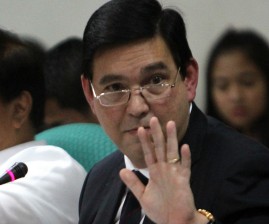Effectiveness of P351B Metro Manila flood control program being questioned
MANILA, Philippines—A congressional inquiry into the “most ambitious and expensive” P351-billion flood control program of government is being sought by an administration ally in the Senate.
Senator Ralph Recto said the Senate should look into the viability of the approved P351-billion overall master plan on flood management in the National Capital Region which is, by far, “the most ambitious and expensive flood control program ever crafted by the national government.”
“Questions continue to inundate our minds as to the effectiveness of this master plan, especially so when flood waters continue to debilitate almost the whole of Metro Manila nine months after this plan was approved,” Recto said in a statement on Friday.
“And before we are neck-deep in doubts if indeed we are wisely spending P351 billion in taxpayers’ money on this project, a congressional inquiry is in order with the end in view of ensuring a comprehensive and cost-efficient solution to the flooding problem in the metropolis,” he said.
In filing Senate Resolution No. 6, Recto took note of the flash floods that virtually crippled Metro Manila last month, submerging major roadways, clogged waterways, rendered intersections impassable and virtually paralyzed public transport, leaving thousands of commuters stranded.
“The flash floods of June have resulted in cancellation of classes, offices and shutting down of other workplaces, which has impacted negatively on productivity,” he said.
Recto explained that the P351-billion flood control master plan, which took 22 years to make, was approved by the national government last year. The Department of Public Works and Highways (DPWH) is the lead implementing agency of the program.
“The master plan on flood management—the most expensive and ambitious at P351 billion—is considered the most urgent that an initial amount of P5 billion has been approved to jumpstart it,” he said.
Completion by 2035
The long-term plan, the senator said, would cover the infrastructure needs of 11 flood-prone areas in Metro Manila and nearby provinces and would see completion by 2035.
Recto said the initial seed money of P5 billion will bankroll the most urgent needs in terms of spending for the improvement of floodways and drainage systems and river capacities in Metro Manila, Central Luzon (Region III), and Calabarzon (Region IV-A).
He, however, noted the statements of the Metro Manila Development Authority (MMDA) that unless the DPWH completes its 70 ongoing drainage projects in Metro Manila such as a flood interceptor in the Espana-Blumentritt area, the metropolis should brace for more floods.
“We need to provide immediate relief to the public against flash floods that threaten Metro Manila during heavy downpour of rain. If we are spending P351 billion in this project, we should know if it will be effective,” Recto said.
Overpumping
The senator then cited a University of Illinois study conducted by Dr. Kelvin Rodolfo, which showed that the overpumping of groundwater has caused Metro Manila and other highly populated areas to sink 20 mm to as much as 90 mm a year particularly in Bataan, Pampanga, Bulacan and Camanava (Caloocan, Malabon, Navotas and Valenzuela) area.
A separate local study, he said, indicated that 41.02 percent of the 273 esteros, creeks and tributaries in the NCR are now virtually “ghosts” or missing as many of these are actually buried under road networks or with establishments built on top of them decades ago.
“This is added to the fact that authorities like the DPWH and MMDA have singled out the clogged waterways and blocked drainages as the main culprits of the crippling flash floods,” the senator pointed out.
What worsens Metro Manila’s flood predicament, Recto said, is the presence of garbage-dumping informal settlers living near these waterways and drainages.
Malacañang has said that it was determined to relocate some 20,000 informal settlers living near waterways, and to file appropriate charges against those who will hinder this project.
Of the 100,000 informal settlers in Metro Manila, 60,000 live near waterways and of this number, some 20,000 are located near the government’s priority waterways whose mere presence put at risk the well-being of 2.2 million Metro Manila residents.
The eight priority waterways identified by the DPWH are San Juan River, Pasig River, Tullahan River, Maricaban Creek, Manggahan Floodway, Estero Tripa de Gallina, Estero de Maypajo, and Estero de Sunog Apog.
